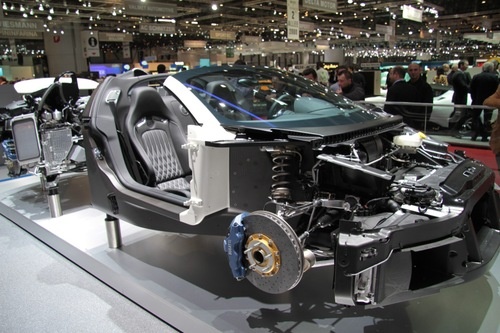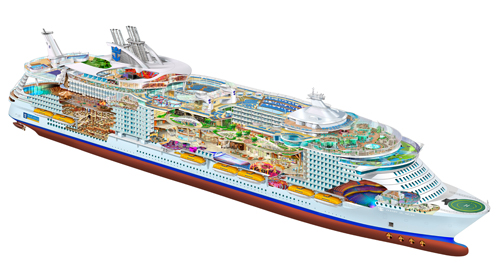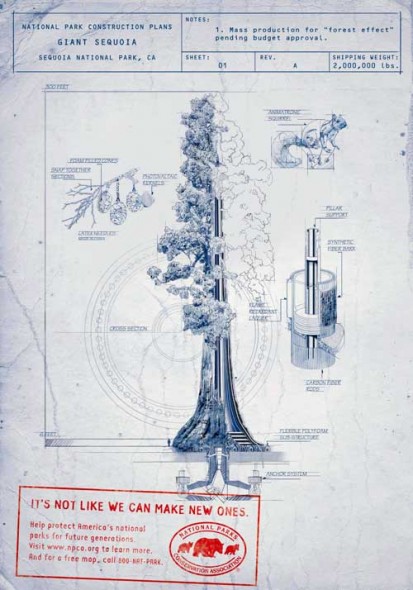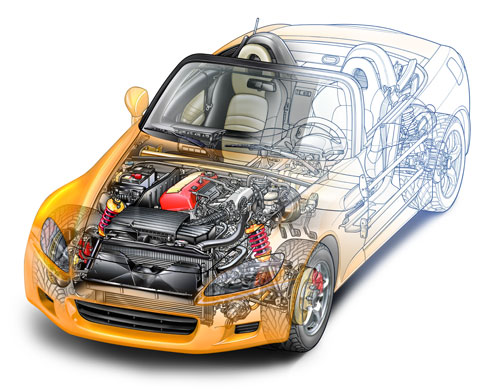
Mercedes-AMG’s Official Global Website is infused with a technical illustration aesthetic that underscores the company’s eighty-plus years of automotive design and innovation.

Mercedes-AMG’s Official Global Website is infused with a technical illustration aesthetic that underscores the company’s eighty-plus years of automotive design and innovation.
“Any subject-matter is no more, or less, complicated than any other if you break it into small enough sections. A big, complex object like a car, plane or ship is just 30 or 40 small illustrations that happen to occupy the same space.”
The career of technical illustrator extraordinaire Kevin Hulsey is nothing short of prolific. His client list reads like a roll call of the world’s major transportation, technology, manufacturing and entertainment companies. His work has been recognized with numerous awards from Belding, Best in the West, Communication Arts Magazine, and the Art Directors Club Of Los Angeles. He began his trade with an airbrush in hand, then traded it in for a Wacom tablet and made the leap to digital media. And his website is an abundant source of inspiration, with illustrations of mind-boggling complexity and accuracy and myriad resources, articles and tutorials.
This all keeps Mr. Hulsey rather busy—unfortunately for us too busy for an interview. However, with his permission, I’ve collected some links to images, resources, and an interview he did with another site:
“Even after nearly thirty years, and thousands of illustrations, it is still fun to see your work on a billboard or in a magazine, particularly when you aren’t expecting it.”
Big thanks to Mr. Hulsey for sharing his time and work with us, and all the amazing resources on his site!
Update: Wacom case-study on Mr. Hulsey. (now on Internet Archive)
All images copyright © 2010 Kevin Hulsey Illustration, Inc. All rights reserved.
httpvhd://www.youtube.com/watch?v=W3HM1bQzubw
Some Friday morning inspiration. Interesting to see behind-the-scenes and hear about the process and concept.
[Doobybrain via Gizmodo]Most people go to auto shows to see the latest bunch of cars they’ll never be able to afford. I go for things like this:

Bugatti Veyron - Máté Petrány
That’s a Bugatti Veyron stripped of it’s panels, and displayed in all it’s glory.
To me, displays like this are the best part of auto shows: the exploded and animated engine, the gutted drive train, the new Mustang that’s been cut in half so that you can walk between it. Seeing into everyday objects and learning how they work has always fascinated me.
I’ve also found that auto shows are a great opportunity for photo reference. Not only may you find a gem like this, but you can also observe all the various textures on the car under ideal lighting conditions.
You can see the rest of the pictures over at Jalopnik, here.

Oasis of the Seas – Alan and Beau Daniels
It’s always good to hear that working technical illustrators are keeping busy, and even though they’ve been neck deep in work, Alan and Beau Daniels were able to submit this questionnaire to me. You can check out their site here at beaudaniels.com.
At what point did you guys become involved with drawing? Both recreational and professional; try to give me the who, when, where, and hows…
I have drawn for as long as I can remember, professionally I started to make a living with the Young Artist agency in London, mostly science fiction illustration. They had tremendous publishing contacts, but no one would give me a break in England until I got the cover of Anarchistic colossus, an American publisher took a chance with me and that helped with the English publishers. There was a lot of work commercially and I was still able to pursue the fine art side. Beau was and is really a science major and business person, the passion for Beau is in chasing the job and managing the process, this works very well for us.

NPCA Poster – Alan and Beau Daniels
What would you consider to be your first BIG GIG as an artist? That is to say, what piece or body of work got your foot in the door of Illustration? Who was involved? What happened after that?
Big break, moving to Los Angeles to work on Blade Runner. There were a large number of illustrators brought over from the Young Artists agency, to work on the film; they had a connection with Ridley Scott from his commercial filming. It was not an easy time working for the Ladd Company and all the other English artists eventually stopped working for them and returned to England. We had already made the commitment to stay, but if we had had the money in the first year we would have returned also. Working for the movie industry you are at the mercy of too many egos, they had the ability to twist you around. But, this was probably the best thing that happened to us work wise. We made lots of contacts, built our credibility and worked out which field of illustration would suite both of our work habits.
Did you guys have a mentor/s? Who were they?
Neither of us have had mentors, but we have been lucky in meeting people who have helped our careers. One collector of my fine art work, on finding out that we were moving to the USA. bought our entire collection of commercial artwork from us, it helped in the expense of moving. He ran Museum Gallery and was a coin merchant in London, and a bit of a philanthropist. A very good man, who we are still in contact with today.

Atlanta Art Building – Alan and Beau Daniels
What did school do for you? (I know that sounds naive, but some say school did not give them much, others say a lot, whats your take). Any particular instructors, classes or groups that propelled you into doing Illustration professionally?
School taught me self-discipline and motivation. Again I was lucky at school, the teachers we had were David Hockney, Roland Piche, David Hall, Phillip Glass, Billy Apple, it was a very progressive college that believed in developing skills not only in your chosen field but also survival skills for the work environment.
Any regrets? If you could go back and do anything differently what would you do?
None at all.
How did you and your wife go about ‘selling/marketing yourselves’? How do you continue to do so?
Beau does the marketing, we have advertised in Workbook, Graphic Artist Guild Book, and Medical artists Book for many years. This form of advertising is being phased out as we get most of our work through our web sites. We have about twenty sites The reason for so many web sites was to narrow them down in content so that they are more specific, e.g. Cutaway-illustration.com — Essentially a simple teaser site to get people to go to the beaudaniels.com site, but also a way of covering a lot more ground on the web.

Ghosted Car – Alan and Beau Daniels
On a personal note…. what is the philosophy behind your craft and work? Are there any deep reasons for why+what you do? Or is it just to pay the bills? What is your philosophy on the ART world in general?
We always do the best work we can; even if as sometimes happens you have underestimated the complexity of the illustration. Sometimes from your own fault, sometimes just misunderstanding and sometimes the client not quite telling the truth at the onset. The latter reason is easier to rectify in that we will ask for a budget increase if we have not been given correct information up front. Once you have committed to a job, the money no longer matters. Try to get something creative wise out of every job you do, that can be difficult! Attitude towards the illustration business is changing, we are finding more and more agency contracts to be unacceptable in their demands, Copyright ownership, work for hire etc. we will not work under either of those conditions, and fight strongly for artists’ rights to their work. I will always draw whether or not I get paid for it, but what I draw, that would be different. Having been on both sides, working commercial illustration and trying to produce fine art. There is now so little difference, fine art through the marketing process has attached itself to the commercial realm. I dislike intensely when the fine art “world” criticizes us for being commercial illustrators. They really don’t like the fact they can’t control you because the commercial work has given us financial freedom.
Tell us about your background?
I live in Newton, which is just outside of Boston. I took art classes at Hofstra University but actually majored in English. After school I got interested in illustration and design while working at an ad agency, so I took a lot of classes at the School of Visual Arts in Manhattan. I started working as a graphic designer for high-tech companies about 15 years ago, and this allowed me to create technical illustration in-house and begin to build a portfolio. I decided to focus on illustration about five years ago and that’s the core part of my work now.
Are you a freelancer or in-house?
I freelance out of a home studio.
Software of choice?
I use Illustrator, Photoshop, and Luxology’s modo for 3d work.
Favorite clients/jobs?
Being an Air Force brat, I’ve enjoyed some military-themed projects for clients like Raytheon and Agility Logistics. I’ve also recently completed some projects in the renewable energy industry, which is very satisfying. Overall, clients that provide solid art direction but allow some freedom to create images that have marketing appeal are ideal.
Any advice for illustrators just starting out?
Always try to create your very best work. Of all the illustration disciplines, ours is perhaps the most demanding as far as accuracy is concerned, so be a perfectionist. Digital tools have allowed us to get lazy to some degree, so be methodical in your execution and scrutinize your work. The results will show for it.
When appropriate, use some creative license in how you approach a project to help it accomplish its communication goals. Sometimes people starting out are too rigid with how they execute an image and they don’t allow themselves to play with the subject matter and compose something that really resonates as a piece of art.
Curtis Sayers’ work can be found at Studio Sayers.